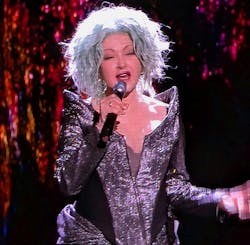Interior Design That Resonates Like Music
I recently saw Cyndi Lauper live during her “Girls Just Wanna Have Fun” farewell tour—thanks to a friend with access to discounted tickets. While the wigs, colors, and ‘80s nostalgia were as dazzling as expected, what struck me most was Lauper’s storytelling—both through her lyrics and candid conversations with the audience.
Rather than getting restless as the singer chatted, the crowd appeared to be relishing that harmonious space between a performer’s public identity and their authentic personal experience. I think we were all sad to close the evening out, even with the unforgettable anthem “Girls Just Wanna Have Fun.”
That blend of entertainment and emotional resonance reminded me of how impactful storytelling can be in another creative realm: interior design.
On the ride home, I was thinking about how powerful it is to show our “true colors”—to feel seen, safe, and included. That’s when it struck me: Purposeful interior design, like music, tells a story. It’s a carefully orchestrated experience that can elevate the everyday and support well-being through harmony in color, layout, light, material, and much more.
This is where trauma-informed design practice can serve: to transform the built environment into a place that respects all people’s experiences, providing refuge and space for their comfort, safety, and healing (page 24).
Even if practitioners don’t explicitly call it “trauma-informed design,” you’ll see in this issue how many are applying principles rooted in environmental psychology—biophilic strategies, universal design, and sensory-sensitive planning—to promote users’ emotional and physical well-being.
Related Podcast Episode
On page 12, FCA principal Jennifer Kenson brings clarity to Carl Jung’s concept of the “Collective Unconscious” and shows how familiar natural elements in healthcare design can reduce stress and move the nervous system toward restoration.
On page 28, i+s editor Lauren Brant examines a Toronto Indigenous women’s shelter, where the design draws on circular forms that reference a deep connection between Indigenous culture and continuity with the natural world.
In a spotlight interview (page 32), Jennie Morton gets the design team talking about the collaborative process that resulted in a cohesive outpatient cancer treatment campus from the exterior through the interior. They reveal how the design creates “pockets of joy” while preserving the need to deliver a soothing experience that cares for both patients and providers.
Ultimately, we all seek spaces where we feel seen, safe, and connected—places that reflect our authentic selves, our true colors. When designers intentionally shape environments that support healing and inclusion, they create opportunities for meaningful social impact—time after time.
About the Author
Carrie Meadows
Editor-in-Chief
Carrie Meadows is Editor-in-Chief of interiors+sources (i+s), where she leads editorial strategy, content development, and brand storytelling focused on the people, projects, and innovations shaping the design industry. With more than two decades of experience in B2B media, she has built a career connecting technical expertise with creative insight—translating complex topics into meaningful stories for professional audiences. Before joining i+s in 2024, Carrie served as Editor-in-Chief of LEDs Magazine within Endeavor Business Media’s Digital Infrastructure & Lighting Group, guiding coverage of emerging lighting technologies, sustainability, and human-centric design. Her earlier editorial experience spans across Laser Focus World, Vision Systems Design, Lightwave, and CleanRooms, where she managed print and digital publications serving the optics, photonics, and semiconductor sectors.
An advocate for clear communication and thoughtful storytelling, Carrie combines her editorial management, SEO, and content strategy expertise to help brands and readers stay informed in a rapidly evolving media landscape. When she’s not crafting content, Carrie can be found volunteering at a local animal shelter, diving into a good crime novel, or spending time outdoors with family, friends, and her favorite four-legged friends.



